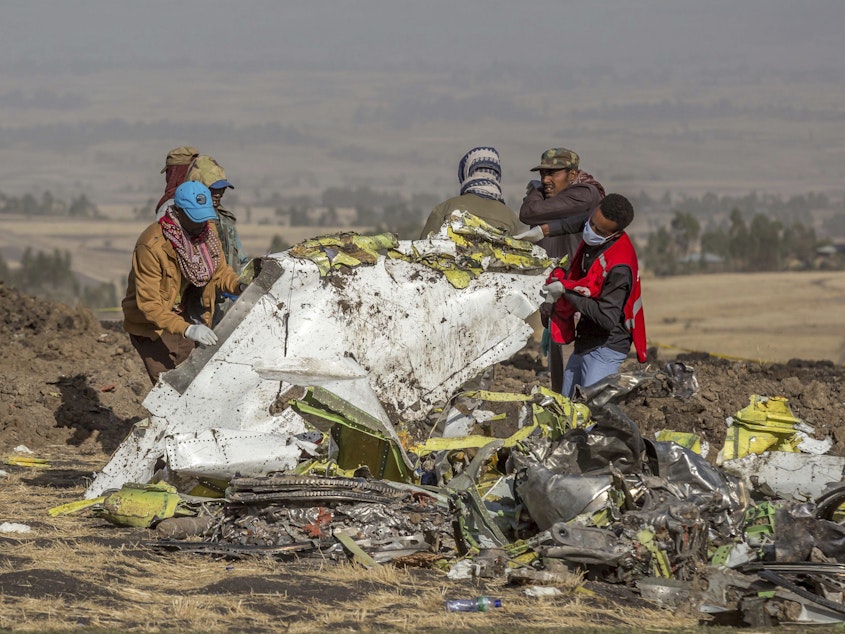Ethiopian Officials Say Faulty Boeing Software Played Role In Deadly 737 Max Crash

Ethiopian investigators said a flawed flight control system triggered by faulty sensor data, is at least partly to blame for last year's crash of a 737 Max airplane operated by Ethiopian Airlines. All 157 people on board were killed.
Authorities in Ethiopia also said training on the Max planes provided by Boeing "was found to be inadequate" adding that the flight control system, known as MCAS, was activated four times as pilots struggled mightily to regain control of the plane before the crash.
The findings of the interim report from Ethiopia's Aircraft Accident Investigation Bureau were released a day before the anniversary of the crash of Nairobi-bound Ethiopian Airlines flight 302.
A Boeing spokesperson said the company continues to extend "heartfelt sympathies" to the families of those killed in the Ethiopian Airlines crash. It also said it is awaiting formal recommendations from the final report.
"Boeing continues to provide technical assistance in support of the investigation, at the request of and under the direction of the U.S. National Transportation Safety Board, the Accredited Representative for the United States. We look forward to reviewing the full details and formal recommendations that will be included in the final report from the Ethiopian Accident Investigation Bureau," Boeing said in a statement.
That doomed flight, plus another one operated by Indonesia's Lion Air that crashed in the Java Sea and killed all 189 passengers and crew in 2018 led to a worldwide grounding of Boeing's 737 Max fleet. That global grounding has been in effect for roughly a year.
The crashes eventually led to Boeing halting production of the planes causing ripple effects through the aerospace giant's supply chain.
MCAS played a role in both the Lion Air and Ethiopian Airlines crashes. It is designed to lower the nose of the plane if sensors measure the AOA or "angle of attack" to be too high, which could cause it to stall.
But in both crashes, the information from the sensors was wrong.
In the Ethiopian Airlines flight, authorities found the plane's left and right AOA sensors differed by 59 degrees. The MCAS system took that erroneous information and activated – repeatedly pushing the plane's nose down during the six minutes it was in the air after takeoff.
The interim report found that at one point "the pitch angle dropped from 0.5 degrees nose up to -7.8 degrees nose down" and as a result the rate of decent increased from 100 feet per minute to more than 5,000 feet per minute.
The report adds that the pilots appeared to have recognized the problem and powered off the MCAS system. They then attempted to manually regain control and trim of the aircraft in order to bring the nose back up.
Eventually, the pilots turned the MCAS system back on, though the report does not explain why. That decision again forced the plane into a nose dive and the pilots were unable to recover.
The report indicates the plane was pointing down at a 40-degree angle and hurtling towards ground at a speed of more than 500 feet per second, when it crashed.
Ethiopian authorities don't cite pilot error as a cause of the crash, but do say the pilots should have received training in a cockpit simulator on what to do in a scenario when MCAS malfunctions.
For Boeing, returning the Max to service has been a top priority, though one that has not come easy. Boeing anticipated a swift return, only to see that goal pushed back several times after regulators, particularly those in the U.S., pushed for more fixes.
This includes reports that federal regulators will issue an order to have some electrical wire bundles relocated on the Max planes because they are too close to one another and could catch fire. Since the grounding, Boeing discovered another potential hazard: tools and other debris such as rags and wrappers were left in fuel tanks during assembly of the planes.
Last month, Federal Aviation Administration officials said certain panels on the Max planes, including a metal layer that provides a shield for aircraft wiring, is prone to potential "electromagnetic effects of lightning strikes or high intensity radiated fields."
Boeing stopped production of the aircraft, which had been its bestselling plane, in December. Soon afterwards effects of the production slowdown began impacting businesses down the supply chain, including that of Spirit AeroSystems, which announced in January it was going to layoff nearly 3,000 employees.
Boeing said earlier this year the company estimates the FAA and other global regulators will move forward with "ungrounding" of the 737 Max by mid-2020. [Copyright 2020 NPR]



